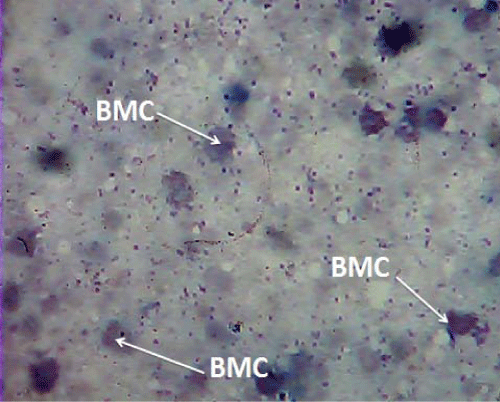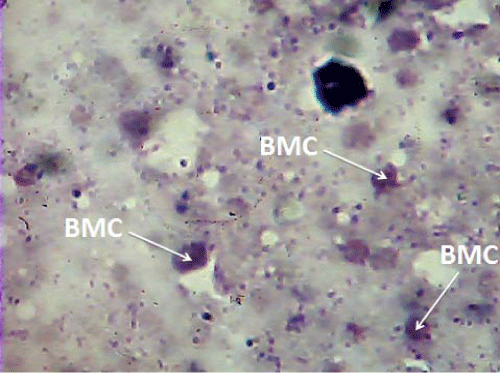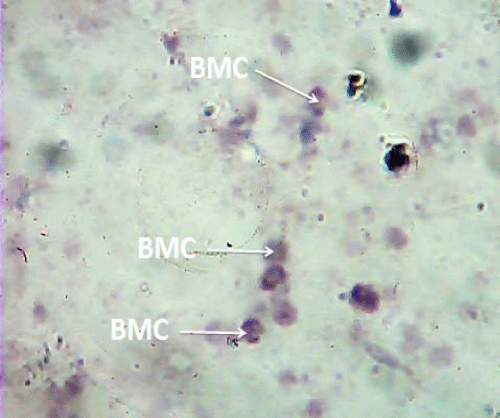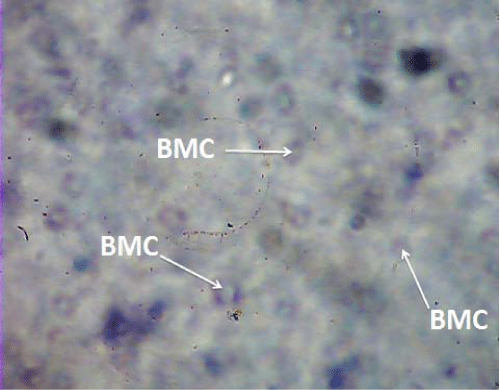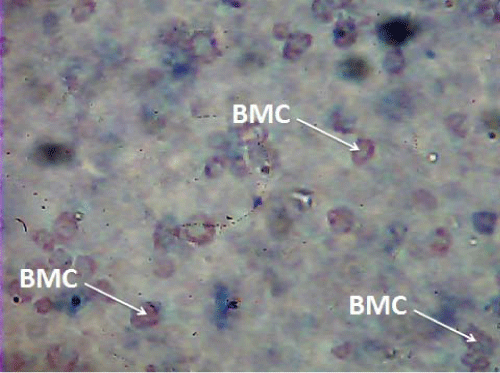| Research Article |
Open Access |
|
| Owolabi JO1*, Opoola E2 and Caxton-Martins EA2 |
| 1Department of Anatomy, Ben Carson Snr. School of Medicine, Babcock University, Nigeria |
| 2Department of Anatomy, College of Health Sciences, University of Ilorin, Nigeria |
| *Corresponding authors: |
Owolabi JO
Department of Anatomy
Ben Carson Sr. School of Medicine
Babcock University, Nigeria
Tel: +2348064884305
E-mail: olaowolabi001@yahoo.com |
|
| |
| Received September 05, 2012; Published September 29, 2012 |
| |
| Citation: Owolabi JO, Opoola E, Caxton-Martins EA (2012) Healing and Prophylactic Effects of Moringa oleifera Leaf Extract on Lead Induced Damage to Haematological and Bone Marrow Elements in Adult Wistar Rat Models. 1:386. doi:10.4172/scientificreports.386 |
| |
| Copyright: © 2012 Owolabi JO, et al. This is an open-access article distributed under the terms of the Creative Commons Attribution License, which permits unrestricted use, distribution, and reproduction in any medium, provided the original author and source are credited. |
| |
| Abstract |
| |
| This study was carried out to observe the regenerative effect of Moringa oleifera extract on Hematological Parameters and Bone Marrow of adult Wistar Rat, using thirty five (35) Rats which were grouped into five. The Rats in group A are the control, which was fed with feed and water alone. The Rats in group B were administered with Moringa oleifera only. The rats in group C were administered with Lead only. The Rats in group D were administered with Lead for the first half of the administration period, and Moringa was administered for the second half of the administration period, while the Rats in group E were administered with Lead and Moringa simultaneously, throughout the period of administration. After sixteenth day of administration, histological experiment was carried out on the blood smear and bone marrow smear, it was found out that lead has a deleterious effect on hematological parameters, as well as bone marrow and in most cases; Moringa oleifera extract reduces the severity of lead toxicity. |
| |
| Keywords |
| |
| Moringa; Blood; Bone marrow; Blood cells; Healing effects; Prophylactic effects |
| |
| Introduction |
| |
| The research is carried out on an adult Wistar rat, to examine and analyse the regenerative effect of Moringa oleifera leaf extract on lead induced hematological parameters and bone marrow, so as to evaluate the regenerative effect of Moringa oleifera leaf extract on lead induced hematological parameters and bone marrow. The increasing use of plant for consumption and medicinal purposes needs proper and efficient research, to know the suitability of plants for the purpose for which they are being used. |
| |
| This will enable us to know which plant is toxic and those that are not, and to know the part of plant best for the purpose they are being used. Hence, it would help us to know the level of interaction permissible between these plants and man as well as other animals. Moringa is an agricultural plant that grows as small trees. It surfaced from India-sub-continent, and has spread to tropical and sub-tropical areas worldwide [1]. Moringa oleifera is the commonest types, among the species of Moringa. It grows high as 9 m, with a soft, white wood and gummy bark. |
| |
| Leaves are alternate, usually thrice pinnate, 25 to 50 cm long. Each component leaf contains 3-9 very then leaflets, about 1-2 cm long. Flowers are white and flagrant, 1.5-2 cm long, pod is 15-30 cm long, seeds are three angled and winged on the angles. Moringa tree has been used for variety of purposes, which includes curing many deadly diseases, hypertension, diabetes, and so on. It is also used for animal forage, alley, domestic cleaning agent, cropping, dye, fertilizer, gum, live fencing ornamentals, plant diseases prevention, honey producer, pulp, rope making, and tannin [1]. In human, according to India tradition of medicine, Moringa increases the natural defense [2]. Moringa possess vitamins that is 10 times the vitamin A of carrot, ½ times the vitamin C of orange, 17 times the calcium of milk, 15 times potassium of bananas, 25 times the iron of spinach and 9 times the protein of yogurt. |
| |
| Moringa leaves is the most used part of Moringa oleifera plant which has been reported after analysis of its phytochemical constituents, to be a rich source of β-carotene, protein, vitamin C, calcium and potassium and natural antioxidants; and thus, enhance the shelf-life of fat containing foods because it contains antioxidants. Carbohydrate compounds like rhamnose and a fairly unique group of compounds called glucosinolates and isothiocyanates were richly present in the Moringa leaves [3]. |
| |
| Moringa oleifera contains the certain phytochemicals, which have been reported to possess anti bacterial features and these include: 1) 4-(α-L-rhamnopyranosyloxy) benzyl isothiocy-anate; 2) Niazimicin; 3) Pterygospermin; 4) Benzyl isothiocyanate; 5) 4-(α-Lrhamnopyranosyloxy), and 6) Benzyl glucosinolate. |
| |
| Apart from this entire compound, Moringa is also very rich in vitamins, minerals, and other phytochemicals like carotenoids which include β-carotene or pro-vitamin A [1]. Nine amino acids, coupled with sugars such as sucrose, D-glucose, and others like traces of alkaloids, and kaempferat, quercetin, wax; calcium and potassium both of which are essential nutrient to the body, are of high quantity in the ash produced by this plant [4]. Also reported are flavonoid pigments, such as alkaloids, kaempherol, rhamnetin, isoquercitrin and kaempferitrin, all present in Moringa plant [5]. |
| |
| The bone marrow is the soft, flexible tissue found in the internal aspect of bones. Parts of bone called hematopoietic compartment produces about 500 billion blood cells daily, this uses the vasculature of bone as a contact to the systemic circulation. On an average, bone marrow is about 4% of the total human body weight and weighs about 2.6 kg. Bone marrow is important in lymphatic system by producing lymphocytes, sustaining body immunity. Bone marrow is classified as: the red marrow and the yellow marrow, also known as medulla ossium flava; mainly fatty in nature. The bone marrow consists of many blood vessels and capillaries. Red blood cells, platelets and almost all the white blood cells are produced from the red marrow. All bone marrow are red at birth; with increase in age, it turns to yellow. Red marrow can be found in flat bones like scapula and epiphyseal end of long bones like femur. Yellow marrow can be found in medullary cavity of long bones; hence, they can be converted back to red marrow for increase blood cell production during severe blood loss. |
| |
| Lead is a shiny, blue-white soft metal, when its surface is fresh. On exposure to the air, it becomes covered by a dull, gray layer of basic carbonate that adheres closely and protects it from further alteration. It resembles aluminum in this respect, which is protected by a dull, gray layer of oxide. Otherwise, lead would react rapidly with the oxygen and carbon dioxide in the air. When placed in sulphuric acid, lead is protected by a similar layer of PbSO4 that adheres strongly [6]. Acute lead poisoning results from ingesting soluble lead compounds. The symptoms were called "painter's colic" since painters, covered with white lead, were at risk. The damage appears to be mainly to the nervous system and the effects not as acute, as those of mercury poisoning. Lead is an accumulative poison, building up until it reaches a toxic level. An antidote after swallowing a soluble lead salt is a stiff drink of Epsom salts, MgSO4, which precipitates insoluble PbSO4 [7]. |
| |
| Lead is stored in the body mainly by compartments like blood, soft tissues and bone. Other tissues that store lead include brain, liver, spleen, kidneys and lungs. Half-life of lead in blood is measured in weeks, while that of soft tissues, in months and for bone, in years. About 94% of lead absorbed in adult is deposited in bone and teeth, and thus generally thought not to be harmful; it is tightly bound and not readily available to other tissues. Though after about 20 to 30 years, there can be reintroduction of stored lead into the blood stream [8]. |
| |
| Literature Review |
| |
| Many studies have shown that Lead is a very poisonous metal that damages almost every organ and system of the body. It has been verified that exposure to lead poison causes little increase in blood pressure, particularly in middle age and older people. Lead poisoning damages kidney, liver, cause anemia, death, and high level exposure reduces fertility in male [9]. |
| |
| An experiment carried out on M. oleifera supplements added to normal daily diet of a laboratory rat, with a very high level of cholesterol in the blood serum has been reported, which reduces drastically and also Moringa leaves contains beta-sitosterol, which is one of its phytochemical; this phytochemical possesses ability to reduce cholesterol in blood. Hence, decrease in cholesterol in the serum of rats [ 10]. Research on ethanolic leaves extract of M. oleifera on streptozocin diabetic wistar rat’s only shows that it possesses hyperglyceties [11]. Study shows that Moringa leaves have a stable influence on blood pressure due to the presence of calcium and potassium, therefore, provides a good source of antioxidants which include glycosides, chlorogenic acid, rutin, quencetin, kaempferol [12]. |
| |
| A study on radioprotective property of Moringa oleifera leaves, using adult swiss albino mice demonstrated that pretreatment with the methanolic leaf extract of Moringa oleifera confers significant radiation protection to the bone marrow chromosomes in mice [13]. Another study shows that exposure to lead acetate reduces the level of antioxidants in bone marrow. Hence, rendering the tissues susceptible to the peroxidative damage [14,15]. Study on the ethanol and aqueous extract of the whole pods and its parts i.e. the coat, seed, shows that the seed has ability to lower blood pressure (antihypertensive), and with the results of both ethanol and water extracts comparable showing a widely distributed effect. Thiocarbamate, isothiocyanate glycosides, methyl p-hydroxybenzoate and β-sitosterol, all isolated from ethanolic extracts activity directed fractionation of the pods of M. oleifera, have all shown hypotensive ability thus, encouraging their use as antihypertensives.[5,16] |
| |
| Materials and Methods |
| |
| Thirty five adult Wistar rats were grouped into five groups randomly; each group had seven rats (n=7). Group A animals served as the control group, and the animals were given normal feed and water. Group B animals were administered Moringa oleifera ethanolic extract only. Group C animals were administered lead only. Group D animals were administered lead for the first half of the administration period, and administered Moringa oleifera ethanolic extract for the remaining second half of administration period. Group E animals were administered both lead and Moringa oleifera ethanolic extract, simultaneously for the duration of administration. |
| |
| A uniform dosage of 50 mg/kg body weight of lead and 100 mg/kg body weight of Moringa extract was adopted. The Moringa extract and lead solution was administered orally, using suitable oral cannula fixed to the end of a calibrated syringe. At the end of administration, the animals were sacrificed by cervical dislocation. The blood was collected from the aorta, after a central medial incision into the thoracic cavity. The bone marrow was collected from the femur bones epiphyses. |
| |
| Blood smears from the collected blood were prepared on glass slides. The smears were stained with the Leishman’s stain. |
| |
| Bone marrow aspirates were collected from the femurs of the animals, and their smears prepared on glass slides. The slides were allowed to dry and thereafter, stained using the Haematoxylin & Eosin techniques as described by Bancroft and Stevens [17]. |
| |
| Results and Discussion |
| |
| Haematological parameters (blood) |
| |
| Haemoglobin level: As presented in Chart 1; Group A male animals (control) had an haemoglobin level of 15.5 g/dl and been the highest across the groups, while female animals of the same group had haemoglobin level of 12.5 g/dl. These groups are taken as been normal and a reference for the treated groups. Male animals in group B had haemoglobin level that is slightly lower than the control. This agree with earlier report of Soyinka [18] that lowering of Moringa group than the control, might be due to some constitutent in the Moringa leaf like glycoides and tannin, which are associated with toxicity. The female animals in the same group has haemoglobin level higher than in the control. Group C had the lowest haemoglobin level across the groups, with the male animal in the group having lower haemoglobin level than in the female. This indicated adverse effect of lead on haemoglobin level in this group. Group D had haemoglobin level higher than group C. However, the male animals had haemoglobin level, still lower than in the control. Group E male animals had haemoglobin level lower than the control. However, haemoglobin level in female animal were higher than control. |
| |
| Thus generally, lead administration reduces haemoglobin level in male and female animal groups, affecting the male more than the female. Moringa increases haemoglobin level, more significantly, in the female animals. Moringa phytochemical extract produced regenerative effect by causing increase in haemoglobin level, either when administered concurrently with lead or after the administration of the later later (lead). This effect is more significant in female than male animals. |
| |
| |
| Packed cell volume (PCV): Chart 2 has the PVC results across the groups. Male animals in control group had the highest packed cell volume, higher than the packed cell volume of female animals in the same group. This is physiologically normal. |
| |
| Administration of Moringa in the group B increases packed cell volume in the female animals. However, there is an increase among the male animals. |
| |
| Group C had the lowest packed cell volume level for both sexes, indicating that lead causes packed cell volume reduction in both sexes, “A deleterious effect”. |
| |
| Increase in packed cell volume in group D and E indicates that Moringa administration could restore normal packed cell volume after a deleterious effect of lead, when administered consecutively or concurrently. |
| |
| Red Blood Cell (RBC): Chart 3 has the RBC results acoross the groups In the male animals, Red blood cell is highest in the control group and lowest in group treated with lead. This agrees with the earlier work of Jonderko [19]. |
| |
| Moringa administration in group B reduces the RBC level compared with the control.This agrees with the earlier report of Soyinka [18]. Administration of Moringa in group D and E causes increase in red blood cell level in this animal group. This effect was better in the group treated with Moringa alongside lead. |
| |
| In the female animals, Moringa when administered alone produced a very significant rise in red blood cell percentage; lead cause a reduction. Moringa however, when administered to the group treated with lead, could not produce increase in red blood cell percentage which correspond to earlier study of Soyinka [18]. This observation suggest that Moringa would produce increase in red blood cell when taken alone in female animals, but might not restore normalcy in the cases of lead poisoning; but this might be possible in male animals. |
| |
| Mean Corpuscular Volume (MCV): Chart 4 has the MCV results acoross the groups. Lead did not produce reduction in MCV in both sexes. In the male animals in group E administered concurrenntly with lead and Moringa, marked reduction in MCV was observable; this might be due to the constituents in Moringa leaf extract that are associated with toxicity [18]. Such effect was however, not observable in female. |
| |
| It however, appears that Moringa administration would rather cause increase in MCV in the female animals, in group D and E. |
| |
| Mean Corpuscular Haemoglobin (MCH): Chart 5 has the MCH results accross the groups. Administration of Moringa appears to elevate MCH, especially in the male animals across groups B, C, D and E, while lead causes MCH reduction in group C. Moringa causes significant increase when administered in groups D and E. |
| |
| Mean Corpuscular Haemoglobin Concentration (MCHC): Chart 6 has the MCHC results across the groups. Moringa appeared to increase MCHC in group B, C and D, except in the male animal of group E. These suggest that Moringa boosts MCHC in both sexes and could prevent adverse effect of lead in MCHC. |
| |
| White blood cell (WBC): Chart 7 has the WBC results accross the groups. Considering WBC, generally male animals in control group has the highest percentage; suggesting highest level of cellular immunity which was also higher than the percentage of female animals in the same group. In group B, Moringa administration increase WBC percentage in female animals, but reduction in male. In group C, lead administration reduced WBC percentage in the male animals to almost zero. However, there was increase that indicates restoration in male animals in group D and E. This observation showed that Moringa could restore damages to cellular immunity caused by lead in group D and E, in the male animal group. |
| |
| Neutrophils: Chart 8 has the neutrophils levels results accross the groups. Neutrophil level was highest in group C male animals, Neutrophil level in this same group C female animals was higher than in the control. This observation suggest trauma that leads to increase in neutrophil production caused by lead. Administration of Moringa in group D and E decreases neutrophils level in the male animal, it however, caused increase in female animals. |
| |
| Lymphocytes: Chart 9 has the lumphocytes levels results accross the groups. Comparatively, Lead administration slightly reduces lymphocyte percentage in group C. Moringa administration however, was seen to cause restoration. |
| |
| Platelet: Chart 10 has the platelets levels results accross the groups. Platelet percentage was highest in male animal of control group, female animal in the same group had lower level. Moringa administration in group B decreases platelet percentage in this group of male animals, but caused increase in female animal compared with control group. Platelet percentage in group C, D, and E were drastically reduced supposedly by lead administration in both sexes. Moringa administration in group D and E could not restore this deleterious effect. Generally, the administration of lead had adverse effect on blood haemoglobin and the administration of Moringa produced regenerative effect in most instances. Level of such effect however, varies in sexes. Lead also appeared to affect cellular immunity, in agreement with report of Jonderko [19]. The effects of Moringa though were positive, certain instances did not appear positively constant. |
| |
| Bone marrow |
| |
| Photomicrographs were taken using Bresser Erudit Transition Microscope, Model Number 51-10000 at magnification of X300. Photomicroph results are complemented by the results on table 1. |
| |
|
|
Table 1: Bone Marrow Histomorphological Observations. |
|
| |
| Group A which is the control group shows normal cellularity-Plate 1, with a leuco-erythroid ratio of 30:70. In animal group B administered with Moringa only, there is slight reduction in leuco-erythroid ratio to 25:75 and cellularity-Plate 2. In group C, Plate 3, that was administered with lead shows slightly reduced body cellularity, and leuco-erythroid ratio was altered to 40:60, this observation indicated a reduction in primordial red blood cell with a compensating increase in primordial white blood cell; suggesting that there was a need to boost the body immunity in this animal group, such a condition is expected to have been caused by lead administration. Group D animal was treated with lead, then Moringa. It also showed normal cellularity when compared with the control, leuco-erythroid ratio also been 25:75. This indicates a positive effect of Moringa administration, especially in the leucocytes restoration to close to the ratio in the control and Moringa treated group- Plate 4. This can be due to presence of calcium and other nutrient in Moringa oleifera. In group E treated with lead and Moringa concurrently-Plate 5, hypercellularity was observed suggesting rapid hematopoesis, to compensate for lead deleterious effect. The leucoerythroid ratio been 30:70, however was normal. These positive effects are supposed to have been caused by the nutrients and phytochemicals in Moringa oleifera, as also suggested by Mekonnen [20]. |
| |
|
|
Plate 1: Photomicrograph of the bone marrow of adult male Wistar rats in the control Group A using routine haematoxylin and eosin stain technique (x300). |
|
| |
|
|
Plate 2: Photomicrograph of the bone marrow of adult male Wistar rats in Group B administered moringa only group using routine haematoxylin and eosin stain technique (x300). |
|
| |
|
|
Plate 3: Photomicrograph of the bone marrow of adult male Wistar rats in Group C administered lead using routine haematoxylin and eosin stain technique (x300). |
|
| |
|
|
Plate 4: Photomicrograph of the bone marrow of adult male Wistar rats in the Group D administered lead only for 8 days and moringa for another 8days using routine haematoxylin and eosin stain technique (x300). |
|
| |
|
|
Plate 5: Photomicrograph of the bone marrow of adult male Wistar rats in Group E administered lead and moringa simultaneously using routine haematoxylin and eosin stain technique(x300). |
|
| |
| Conclusion |
| |
| Lead generally has deleterious effect both in haematological parameter observed, as well as hematopoesis in the bone marrow, by reducing haemoglobin concentration and or capacity, as well as altering the leuco-erythroid ratio in the bone marrow as a sign of cellular immunity inbalance. Moringa in almost all cases, produced effect that were positive while in most instances, being regenerative or healing and in some other instances reducing the severity of lead toxicity. Moringa on its own, also appear to improve the quantity of blood haemoglobin, when administered. |
| |
| |
| References |
| |
- https://books.google.co.in/books/about/The_Miracle_Tree.html?id
=V0bEOQAACAAJ&redir_esc=y
- Rummel DJ (2005) Useful Plants of the Philippines. A Scientific Guide to Modern Botanical Medicine. Vol 1, C & E Publishing Inc, Quezon City.
- Fahey JW (2005) Moringa Oleifera: A Review of the Medical Evidence for its Nutritional, Therapeutic, and Prophylactic Properties. Part 1. Trees for Life Journal 1:5.
- Ruckmani K, Kavimani S, Jayakar B, Anandan R (1998) Anti-ulcer activity of the alkali preparation of the root and fresh leaf juice of Moringa oleifera lam. Anc Sci Life 17: 220-223.
- Faizi S, Siddiqui BS, Saleem R, Siddiqui S, Aftab K, et al. (1994) Isolation and structure elucidation of new nitrile and mustard oil glycosides from Moringa oleifera and their effect on blood pressure. J Nat Prod 57: 1256-1261.
- Bray JL (1947) Non-Ferrous Production Metallurgy. (2nd Edition), Chapter 14, John Wiley & Sons, New York.
- Higgins RA (1971) Engineering Metallurgy. (3rd Edition), The English Universities Press. Equilibrium diagrams, London.
- Rubin R, Strayer DS (2007) Rubin's Pathology: Clinicopathologic Foundations of Medicine. (5th Edn), Lippincott Williams & Wilkins.
- https://www.amazon.com/Metals-Fertility-Reproductive-Toxicity-Golub/dp/041570040X
- Ghasi S, Nwobodo E, Ofili JO (2000) Hypocholesterolemic effects of crude extract of leaf of Moringa oleifera Lam in high-fat diet fed wistar rats. J Ethnopharmacol 69: 21-25.
- Tende JA, Ezekiel I, Dikko AAU, Goji ADT (2011) Effect of ethanolic leaves extract of moringa oleifera on blood glucose levels of streptozocin-induced diabetics and normoglycemic wistar rats. British Journal of Pharmacology and Toxicology 2: 1-4.
- Atawodi SE, Atawodi JC, Idakwo GA, Pfundstein B, Haubner R, et al. (2010) Evaluation of the polyphenol content and antioxidant properties of methanol extracts of the leaves, stem, and root barks of Moringa oleifera Lam. J Med Food 13: 710-716.
- Rao AV, Devi PU, Kamath R (2001) In vivo radioprotective effect of Moringa oleifera leaves. Indian J Exp Biol 39: 858-863.
- Ercal N, Gurer-Orhan H, Aykin-Burns N (2001) Toxic metals and oxidative stress part I: mechanisms involved in metal-induced oxidative damage. Curr Top Med Chem 1: 529-539.
- Michiels C, Raes M, Toussaint O, Remacle J (1994) Importance of Se-glutathione peroxidase, catalase, and Cu/Zn-SOD for cell survival against oxidative stress. Free Radic Biol Med 17: 235-248.
- Faizi S, Siddiqui BS, Saleem R, Aftab K, Shaheen F, et al. (1998) Hypotensive constituents from the pods of Moringa oleifera. Planta Med 64: 225-228.
- Bancroft JD, Stevens A (1982) Theory and Practice of
- Soyinka E (2004) The review of natural products with antimicrobial activity. Natural Product Report, 20: 56-79.
- Jonderko G, Kujawska A, Langauer-Lewowicka H (1971) Problems of chronic manganese poisoning on the basis of investigations of workers at a manganese alloy foundry. Int Arch Arbeitsmed 28: 250-264.
- Mekonnen Y, Jiru D, Sonder K (2007) Screening of Moringa accessions for Nutritive Value and Palatability. Proceedings Ethopian Institute of Agricultural Research Addis Ababa, Ethiopia, 383-89.
|
| |
| |

